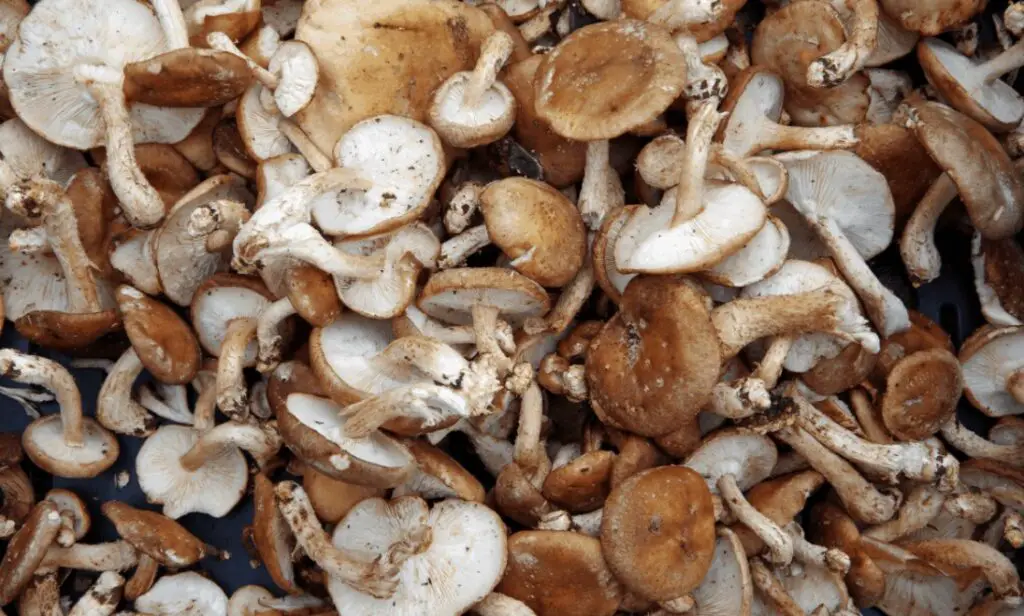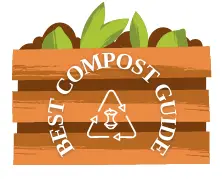Mushroom compost is a great kind of compost that helps many plants to grow happily and healthily. But what if you have those plants that don’t like mushroom compost?
Let’s find out more about mushroom compost and plants that don’t like it!

- Key facts about the mushroom compost
- What is mushroom compost?
- Is mushroom compost safe to use?
- Mushroom soil vs. Mushroom compost
- Is mushroom compost better than regular compost?
- Is mushroom compost good for all plants?
- Is mushroom compost good for succulents?
- Can mushroom compost burn plants?
- What can you mix with mushroom compost?
- Top 20 plants that don’t like mushroom compost
- #1. Aster
- #2. Azalea
- #3. Blueberry
- #4. Camelia
- #5. Cranberry
- #6. Fern
- #7. Fruit bushes
- #8. Gardenia
- #9. Geranium
- #10. Heather
- #11. Holly
- #12. Hydrangea
- #13. Japanese maple
- #14. Juniper
- #15. Lupine
- #16. Magnolia
- #17. Rhododendron
- #18. Sage
- #19. Salvia
- #20. Zinnia
- Final thoughts
Key facts about the mushroom compost
What is mushroom compost?
Mushroom compost is an organic compost made with scraps from the mushroom harvest. It is also called “spent mushroom compost”, as it comes from mushroom farming.
Mushroom compost is rich in different organic materials and nutrients. But the main feature of the mushroom compost is water retention. As it is made of decaying mushrooms, there is a high level of salts in the compost that helps to retain moisture and loosen up the soil structure.
Is mushroom compost safe to use?
Since farmers sometimes use chemicals when cultivating the mushrooms, the chemical residues can get into the mushroom compost.
The best idea is to get the mushroom compost from trustworthy farms. Don’t hesitate and ask questions of the farmers to know more about their mushroom-growing techniques.
Mushroom soil vs. Mushroom compost
Are mushroom compost and mushroom soil the same thing?
In some ways, they are similar. Both of them are organic materials. However, there is an evident difference.
Mushroom compost is specifically designed for performance, while mushroom pieces are added to the compost on purpose.
Mushroom soil has a natural origin. It is an organic material left over following mushroom growth. These are the mushrooms grown to be composted.
Some spent mushroom soil can be used as compost. However, not all kinds of mushroom soil are good for this.

Is mushroom compost better than regular compost?
Adding mushroom compost to the soil is good for many plants. It helps them to absorb nutrients, enriches the soil with salts and calcium, and retains enough moisture for the plants to grow.
Use it in the vegetable garden, for growing fruit trees, and for some types of flowers growing in containers.
Keep in mind that not all plants like mushroom compost for many reasons.
Is mushroom compost good for all plants?
As mushroom compost is rich in organic matter, there is a high concentration of salts. The decaying mushrooms create an alkaline soil, that is good for some plants. However, for acid-loving plants, it is not good at all!
These plants do badly in the mushroom compost, as the alkaline soil has the opposite effect on them. For some seeds, alkaline soil is disastrous, as it can kill the seeds before they germinate.
Ericaceous plants thrive in acid soil, so you can’t plant them in the mushroom compost. Such plants as holly, azalea, aster, Japanese maple, hydrangeas, and blueberries prefer acidic soils, so they will dislike the pH level in the mushroom compost.
Plants, that need enough drainage in the soil, won’t like mushroom compost as well.
Some mushroom composts are quite neutral. Their pH level can be about 6.6 to 7.
Mushroom compost is good both for an annual and a perennial bed. Make a 3-inch layer over the annual or perennial bed, and dig it down 6 inches before planting. Water it regularly and watch out for weed growth.
With mushroom compost, you don’t need any extra fertilizers or herbicides during the whole season.
Is mushroom compost good for succulents?
Although mushroom compost is perfect for tropical houseplants that prefer moist soil, never add it to potting soil for succulents, cacti, or any other plants that like dry soil.
Can mushroom compost burn plants?
As a specific kind of compost, can mushroom compost burn plants?
Yes, mushroom compost can cause leaf burn. Because of the high salt content, it can retain water in the plant’s tissues. You can end up with yellowing or browning of the leaves, that finally leads to death.
The high levels of soluble salts can also make the roots of plants rot.
What can you mix with mushroom compost?
Mushroom compost can come in blends as well.
One of the most common commercial blends of mushroom substrate contains a mix of wheat straw, gypsum, and horse or poultry manure. Other ingredients are also possible, but these are the most popular.

Top 20 plants that don’t like mushroom compost

#1. Aster
Aster is a perennial plant with lovely purple flowers. It is one of the most popular ornamental flowering plants, but in fact, not every soil is good for asters.
Asters prefer neutral or slightly acidic soil, with pH levels from 5.8 to 6.5. As you can see, these plants dislike mushroom compost.
What can you add?
Aster loves well-draining and multipurpose types of compost. They need some moisture, but not too much. Water them at least once a week since they mature fully.
Improve the soil quality by adding some organic matter or chicken manure.

#2. Azalea
Azalea is a flowering shrub from the Rhododendrons family. It needs constant moisture soil, fool sun, and completely acidic soil. The pH range mustn’t be less than 5.5 to 6.2 to keep the bushes green and healthy.
Azaleas are capricious flowering plants that don’t like mushroom compost. The alkaline soil with mushroom compost is the shortest way to kill them.
What can you add?
The best compost for azaleas is loam-based compost. For better application, you can also use granular fertilizer.
A good idea is to get Dr. Earths fertilizer. It works great with Azaleas, Camelias, Gardenias, and many other garden flowers as well.
Never add any peat moss in the soil for azaleas! They don’t like any, and you will end up soon with yellowing leaves on the bushes.

#3. Blueberry
Blueberries are famous for their delicious pies and jams. These berries are rich in antioxidants that are helpful for our health and can be a great addition to our daily diet.
Blueberry bushes like slightly acidic soil and some peat moss. Full sunlight and regular watering are also essential.
As blueberries don’t need too acidic soil and like moist soil, they seem to be good for growing in mushroom compost. However, its soluble salts can harm your plant. Growing blueberries in the mushroom compost, be ready to leave without any berries at all.
What can you add?
Blueberries don’t mind the soil amendments. Use any fertilizer that can keep the acid soil. If the fertilizer contains ammonium sulfates, it is your best bet!
Opt for fertilizers that are good for plants that like lower pH levels.

#4. Camelia
Camelias are acid-loving plants. Instead of mushroom-composted soil, they prefer Ericaceous or acidic soil.
The ideal pH level for camellias is from 5.5 to 6.5.
What can you add?
If you are going to grow camellias in soil with a neutral pH level, a good idea is to add some vegetable compost to the planting hole.
Opt for such variants as composted bracken, handmade leaf mound, or composted pine needles.
You can also cover the soil with these amendments.

#5. Cranberry
Cranberries are easy to take care of and provide you with bright-red berries. They are both delicious and good for your health.
Like any other Ericaceous plants, cranberries can’t grow in alkaline soil, so they don’t like mushroom compost.
Acidic soils with a pH level from 4.0 to 5.5 are the most optimal for cranberries. For the optimum outcomes, they require a pH range of 4.0 to 5.5. To control the soil moisture, drainage, and acidity, plant cranberries in the grow beds.
What can you add?
Use a nitrogen-containing fertilizer. Nitrogen is a vital nutrient for cranberries, and lack of nitrogen is a common issue for the soil.
In the early spring, add a handful of fertilizer around the growing plant. For the best effect, keep fertilizing cranberries during the growing season.

#6. Fern
Ferns are fancy-looking and special plants. Their uniqueness is reproducing via spores. For most plants, this is an uncommon way to reproduce.
Ferns are quite versatile. These plants thrive in alkaline, neutral, and acidic soils. However, they mostly prefer acidic soil. Neutral soil is also good to choose from, though it is less efficient.
What can you add?
Add some vegetable peelings or lawn cuttings as the soil amendments. For a fern grown as an indoor plant, opt for a well-balanced fertilizer with a 20-20-20 formula.
So, what about mushroom compost?
Too acidic soil is bad for ferns. Since mushroom compost lowers the pH, use it to neutralize the excess acids and optimize the pH level. Apply mushroom compost if the soil is too acidic, and the pH level becomes about 5.0 to 6.0.
In addition, ferns love moisture. Some mushroom compost can also help to keep the soil moist.

#7. Fruit bushes
Soft fruit bushes can thrive in different soil types. However, the best soil for them should be rich and well-drained. Heavy and saturated soils are not good for them, so you shouldn’t add mushroom compost.
What can you add?
If you have clay soil, dig in a lot of organic debris.

#8. Gardenia
Gardenia is one more flowering plant that doesn’t like mushroom compost. To produce their wonderful white flowers with an amazing smell, gardenias need optimal pH levels between 6.0 to 7.0.
However, if you plant gardenias close to your house’s foundation, keep in mind that the acid level here is too high for them.
For healthy growth, Gardenia needs enough drainage as well. To provide it, add some pumice or perlite to the soil.
What can you add?
During the growing season, Gardenia requires regular fertilizing. So, depending on how rich in nutrients is your soil, apply the fertilizer every 2-4 weeks.
You can use the same fertilizer as for the Azalea plants.
However, going organic is also a good idea. Opt for all-natural fertilizers, such as blood meal, bone meal, and fish emulsion.
What if the soil is too acidic?
Like ferns, Gardenias don’t like too acidic soil. So, the applied mushroom compost in a small amount can neutralize the excess acid.
Nevertheless, avoid too much of it, so as not to lower the pH level more than you need.

#9. Geranium
Geraniums are extremely popular and widespread ornamental flowers. They are easy to grow and maintain, produce nice colorful flowers, and look very nice.
You can find different kinds of geraniums in flower beds, in hanging baskets, and in many other growing containers.
Geranium is one more plant that doesn’t like mushroom compost. The best pH level of the soil for them is from 6.0 to 6.5, and no spent mushroom compost is necessary.
What can you add?
To boost plant growth, opt for nutrient-rich organic compost. Besides, a slow-release fertilizer works great with geraniums. Mix some worm composting with vegetable waste, and this compost will encourage the flowers’ growth.
You can use some bone meal as a slow-release fertilizer as well. However, if you prefer commercial fertilizers, get Dr.Earths fertilizer. In addition, this type of fertilizer also works perfectly with Azalea and Camelia!

#10. Heather
Heathers are also plants that don’t like mushroom compost. They like slightly acidic and damp soil. They can also grow in very poor and rocky soil, but the acidity is crucial.
What can you add?
For neutral or alkaline soil, opt for acidic additives such as wet peat moss, pine needles, or well-rotted leaf mold.
#11. Holly
Holly plants thrive in acidic soils. Like any Ericaceous plants, they don’t like mushroom compost.
Alkaline soils make the holly leaves yellowing. Besides, the holly plant doesn’t like moisture.
What to add?
For happy holly plant growth, add peat moss, mulch, and pine needles around it to increase the soil’s pH level.
#12. Hydrangea
It is a popular garden shrub with colorful flowers. What is interesting, the pH of the soil affects the colors of flowers!
Using mushroom compost can lead to all pink flowers on the shrub. For blue and lilac flowers, don’t use mushroom compost, as it affects pH level and is responsible for the pink flowers.
What can you add?
Hydrangea likes all-purpose and balanced fertilizers. Add them at least twice during the growing season.
#13. Japanese maple
These are low-maintenance trees that prefer sandy or loamy soils with a little acidity. Don’t mix their soil with mushroom compost.
What can you add?
Opt for a well-rotted compost pile. You can also choose a slow-release or controlled fertilizer.
#14. Juniper
Actually, junipers are trees, but many gardeners grow them as shrubs.
Both of them can grow in different soil conditions and accept many soil amendments. The optimal conditions for junipers are in slightly acidic soil.
Junipers need nutrient-rich soil that provides proper drainage. In the moist-retaining mushroom compost, their roots will decay very soon.
The pH level in the soil shouldn’t be over 5. So, mushroom compost is not good for junipers.
What can you add?
Make a great combination that provides proper drainage. You can use garden soil, organic matter, and small stones like gravel.
#15. Lupine
Lupine flowers grow in groups with highly organized structures. In these groups, you can easily find the leader and the followers, like in wolves’ and dogs’ behavior. That’s why Lupine gets its name from the Latin “lupus” which means wolf.
The lupine plants thrive in soil with a pH from 5.5 to 7.0, as well as in highly acidic environments. So, the mushroom compost is not what you need for them.
What can you add?
You don’t need to fertilize the lupine much, as the plant will focus on foliage production instead of blooming.
The beat fertilizer for lupines should contain phosphorus rather than nitrogen. Phosphorus is essential to boost flowering rather than foliage.

#16. Magnolia
Magnolias are a whole genus of flowering trees. There are about 340 different species, with each plant unique. Because of their amazing flowers of different shapes and colors, Magnolias are so popular among gardeners.
Magnolia prefers pH levels from 5.5 to 6.5. Avoid using mushroom compost when growing it.
What can you add?
Nutrient-rich soil is essential for Magnolia. Before planting, add to the soil some organic compost, or well-composted manure.
To boost foliage and flower growth, you can also opt for ripe compost or nitrogen-containing fertilizer.
#17. Rhododendron
Rhododendrons are plants that don’t like mushroom compost. They thrive in pH ranges of 4.5 to 6.0 and don’t like calcium in the soil.
What can you add?
Any soil additives that work best with Ericaceous plants are good for rhododendrons.
#18. Sage
An evergreen shrub in which flowers and dried leaves are used in medicine and cooking.
Sage likes growing in soils with pH levels from 6.0 to 7.0. Avoid mushroom compost, as sage won’t grow in alkaline soil.
What can you add?
Sage doesn’t need many fertilizers. Mulch it 3 inches deep to retain water and prevent weeds.
For happy and healthy growth, you can add some regular compost or a bit of manure.
#19. Salvia
Salvia plants are easy to grow. Many types of Salvia can grow in regular garden compost combinations.
However, depending on the variety, salvias can prefer wet or practically dry soil conditions.
For salvias, the optimal pH level in the soil is between 5.5 and 6.5. So, the mushroom compost is not good for them.
What can you add?
Salvias don’t like any fertilizers. You would rather add some organic compost. Add some soil sulfur, aluminum sulfate, or chelated iron to the soil to improve the growing conditions.

#20. Zinnia
Zinnias are annual plants with colorful flowers. They are not needy and can tolerate even dry conditions.
The best soil for zinnias is well-draining and fertile potting. So, they don’t need mushroom compost.
What can you add?
Don’t fertilize zinnias too much. They prefer well-balanced fertilizers, like Burpee Bone Meal Fertilizer. It contains enough calcium and phosphorus to boost flowering.
Final thoughts
Some garden and vegetable plants can like or dislike mushroom compost, depending on their soil preferences.
Mushroom compost is your best bet for alkaline-loving plants. But for acid-loving plants, the results can be dramatic.
Always watch out for the soil preferences before choosing the compost for your plants!
Read also: How to compost wood chips fast: a step-by-step guide and useful tips for gardeners











